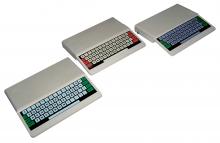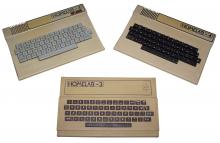The John von Neumann Computer Society will hold its Forum on ICT History in room F05 at the Óbuda University at 15.00 p.m. on 25 April (http://njszt.hu/neumann/esemeny/20130415/njszt-itf-a-primo-es-a-homelab-tortenete). The subject of discussion will be the story of two legendary microcomputers, Primo and HomeLab, which were developed entirely in Hungary.
 Blueprints for Primo were made by SZTAKI (Institute for Computer Science and Control). Seven to nine thousand machines were manufactured between 1984 and 1986. Manufacturing was done at New Life Agricultural Cooperative (Új Élet MgTsz) in Sárisáp, distribution by Microkey/Cosy. A number of versions marked the development of the machine: type A with capacitive keyboard, type B with normal push button keyboard, and the forever prototype Pro/Primo with colour display and ergonomic keyboard. The last series even had the capacities to manage Commodore 1541 floppy drives. Television sets and cassette decks were connectable peripheries to these computers.
Blueprints for Primo were made by SZTAKI (Institute for Computer Science and Control). Seven to nine thousand machines were manufactured between 1984 and 1986. Manufacturing was done at New Life Agricultural Cooperative (Új Élet MgTsz) in Sárisáp, distribution by Microkey/Cosy. A number of versions marked the development of the machine: type A with capacitive keyboard, type B with normal push button keyboard, and the forever prototype Pro/Primo with colour display and ergonomic keyboard. The last series even had the capacities to manage Commodore 1541 floppy drives. Television sets and cassette decks were connectable peripheries to these computers.
 HomeLab computer was designed around 1982 as well by József Lukács and Endre Lukács. This type was constructed also at home by the members of the Hungarian HCC Club, but various versions were manufactured in cooperatives. Homelab-2, called Aircomp-16, was manufactured in small numbers. The production of Homelab-3 and Homelab-4 computers was done by COLOR Industrial Cooperative in Dombóvár. It was here that Brailab, a version of the computer with speech synthesizer, was constructed. Speech module for Brailab was designed by András Arató and Teréz Vaspöri, experts at the Central Research Institute of Physics (KFKI). Brailab had a significant role in the computer education of blind and partially sighted people.
HomeLab computer was designed around 1982 as well by József Lukács and Endre Lukács. This type was constructed also at home by the members of the Hungarian HCC Club, but various versions were manufactured in cooperatives. Homelab-2, called Aircomp-16, was manufactured in small numbers. The production of Homelab-3 and Homelab-4 computers was done by COLOR Industrial Cooperative in Dombóvár. It was here that Brailab, a version of the computer with speech synthesizer, was constructed. Speech module for Brailab was designed by András Arató and Teréz Vaspöri, experts at the Central Research Institute of Physics (KFKI). Brailab had a significant role in the computer education of blind and partially sighted people.
